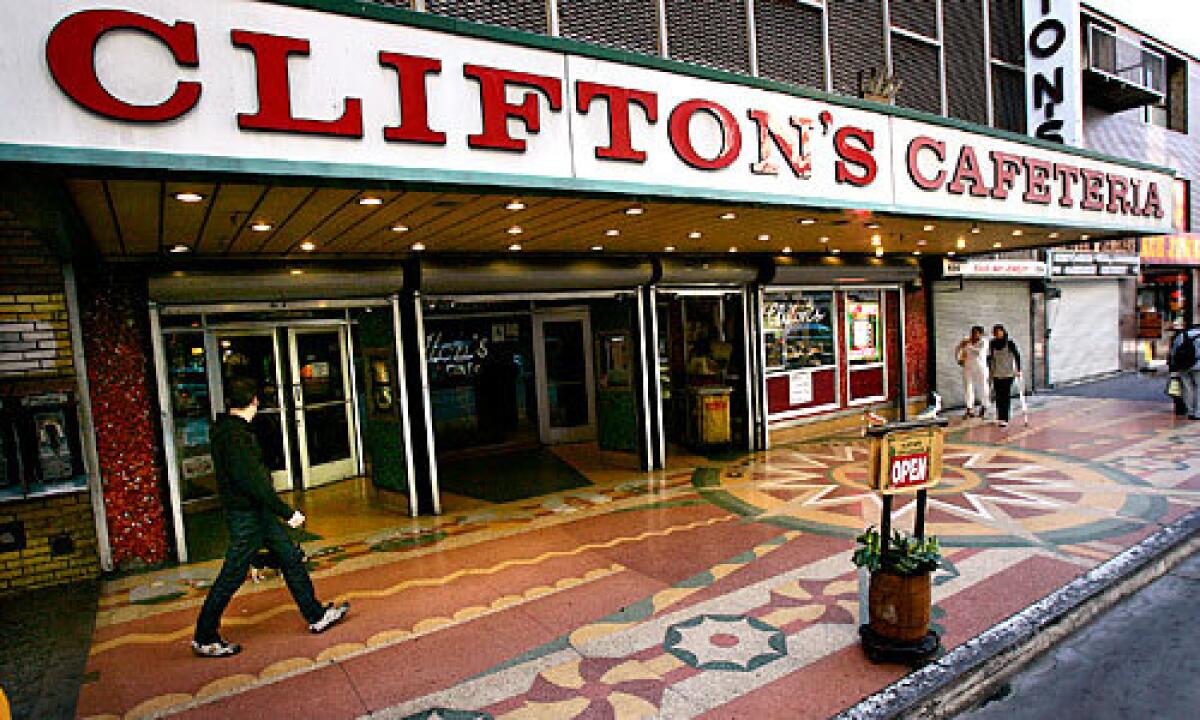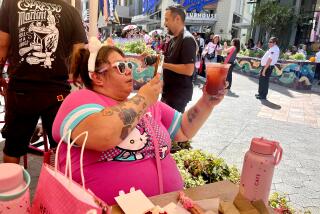Cliftonâs cafeteria: The place where L.A. finds itself

On Broadway downtown -- amid a jumble of shops selling gold necklaces and sports socks and electric guitars, amid exhaust and noise and has-been theaters, amid hipsters, the down and out and the just plain out of it -- an authentic piece of history goes about the business it began during the Great Depression, feeding everyone who walks through the glass doors.
Wander into Cliftonâs Brookdale, the cafeteria on Broadway at 7th Street, and it might seem obvious what makes it unique. Perhaps the waterfall that cascades over several ledges. Or the huge moose head hanging on a wall overlooking one of the dining rooms and the bear holding a fishing pole. Maybe the tiny -- and popular -- tree trunk chapel with its neon cross and inspirational recorded message. But itâs more than these.
Walk the winding cafeteria line and choose tiny red and green cubes of Jell-O (or three or four other kinds), liver (beef or chicken) and onions. Or stuffed peppers, pot roast, deviled salmon or Vienna loaf. Coleslaw, corn bread. Or, all of the above.
Dessert greets diners with their trays at the start of the line, and itâs the last food on the stainless steel racks leading to the quick-fingered cashiers: tapioca and rice puddings, raisin pie. And the cakes: chocolate banana cream, red velvet, carrot, German chocolate, strawberry cream -- all made on the fourth floor under the direction of Margareto Sanchez, the 64-year-old baker who has worked at Cliftonâs since 1968.
At lunch one day recently, local historian Charles Phoenix called Cliftonâs the âworldâs greatest place to eat.â He conducts downtown tours and has brought thousands of people over the years to Cliftonâs to experience the collision of down-home and theatricality. âBut when you get down to the nitty-gritty of whatâs so special, itâs the people,â Phoenix says.
Cliftonâs, with more than 600 seats on three floors, is the last remaining of eight cafeterias around Los Angeles that the Clinton family has owned since 1931. It must be one of the most diverse spots in the city -- ethnically, economically, just about any way you cut it. Itâs like home is supposed to be, a place where they take you in no matter what, where youâre respected even if you donât fit in perfectly elsewhere.
A woman whose close-cropped hair is dyed in a leopard pattern carries her tray through one morning at Christmastime. At lunch another day, a family of five pauses to say grace, the two little boys join hands in prayer before eating fried chicken legs. Another table has the unlikely trio of a young black woman whose face is obscured by a hoodie, a middle-aged Middle Eastern man in a yarmulke and a conservatively dressed balding white man.
The average check is about $8; Thanksgiving dinner was $6.89, $4.99 for kids. Cliftonâs sells the comfort of rice pudding or stuffed cabbage, neither fancy nor fabulous. The goal is affordable standards, homemade, not haute. Todayâs leftovers make tomorrowâs soups.
The place is âkind of an equalizer,â says Robert Clinton, who today owns the cafeteria with his father, Donald. âSome of our prejudices may be lessened.â
Itâs also a place full of regulars, people who have come to Cliftonâs for decades, as children after church, perhaps, or while shopping with their parents.
âI canât change any condiment or spice -- they would know,â Armando Orta, a food manager, says in amazement.
On the first floor, tables are often shared, and though there are no rules, people who wish to eat alone usually head up the stairs. (âBusboys,â often women, will carry dinersâ trays for them if desired.)
Many mornings around 7:30 on Cliftonâs second floor, a group of regulars gathers, spreading out over four or five tables. They donât come in together and they donât actually sit together, preferring to talk across the tables. They talk sports and politics, work on crosswords, read newspapers or use a laptop.
Van Jones says some of them have been coming off and on for 30 years, originally sitting in the smoking section.
âWe donât have anything else in common other than that we come here,â Jones says. âBut let me tell you something. If you get this whole group together, I donât think thereâs a topic thatâs sacred.â
They like being left alone and sometimes keep the chairs warm until 10 or so.
âYou come here and itâs like coming home,â says Jones, 63, a widower and father of two grown daughters.
Ownerâs philosophy
The cafeteriaâs founder, Clifford Clinton, made the Golden Rule a pillar of his business philosophy: How would you like to be treated?
âWhen things happened that required a difficult decision, he would ask that question, and answer it honestly. Sometimes it cost money, and it was painful,â says Robert Clinton, Cliffordâs grandson. âWe try to do that.â
And these days it is painful.
In the restaurantâs busiest period, the 1940s, lines would form down Broadway, with as many as 10,000 customers coming through the door on a good day. Today, Cliftonâs serves 1,800 to 2,000 people a day; Sundays are busiest.
Clifford Clinton sought a half-cent profit per customer. âThat doesnât pay the utilities today,â says Donald Clinton, a lean and graceful 82-year-old sitting in his small, third-floor office full of photographs heâs taken around the world. For a time, Clinton ran the company with his brother and sister. His brother eventually left to become a lawyer. His sister, Jean Clinton Roeschlaub, stayed until her death in 2005, when she was killed at her Glendale home by an unknown assailant. (The county last month authorized a $20,000 reward for information in the case.)
In 2006, the Clintons bought the building that houses the cafeteria, shielding it from the vagaries of leasing. But business has been down 30% in the last six months, Donald Clinton says. âWe are trying to survive during difficult times.â
Not for the first time.
Feeding the poor
Clifford Clinton was born in 1900 and, as a child, accompanied his parents, who owned cafeterias in San Francisco, on a missionary trip to China, where he encountered the extreme poverty that forever infused his approach to work and to life.
In 1931, he and his wife, Nelda, opened the first Cliftonâs (a merging of his first and last names) on Olive Street. Cliftonâs Brookdale opened in 1935 at a time when there were plenty of cafeterias and with a motto that practically courted failure: âDine Free Unless Delighted.â
Cliftonâs never lacked for customers then -- even if those customers sometimes lacked money.
As a boy, Donald recalls helping out on weekends filling water glasses. He also recalls that Cliftonâs handed out thousands of cardboard containers of free food, with wooden spoons, out the back door.
According to the company, 10,000 people ate free in one 90-day period. To cope, Clintonâs opened an emergency âPenny Caveteriaâ in a basement on Hill Street and over the next two years fed 2 million people. Some paid the penny for a dish; those who couldnât afford it instead paid with meal tickets that donors had bought and distributed.
âHe could have gone bankrupt honoring his childhood promise were it not for faithful suppliers, generous vendors and the grace of God, who saw him through those difficult days,â a company brochure said.
By the end of World War II, Clifford Clinton saw that postwar hunger would be a problem in many parts of the world.
He and his wife funded work by Henry Borsook, a Caltech biochemist, that led to the development of a soy-based high-protein supplement called MultiPurpose Food that cost less than 5 cents a portion. The Clintons in 1946 founded Meals for Millions, now the Davis, Calif.-based Freedom From Hunger Foundation, which used MultiPurpose Food to feed people in many countries.
As a prominent family with strong beliefs, they also were involved in politics. Clifford and his son Edmond were part of a 1938 recall movement that ousted Los Angeles Mayor Frank Shaw over charges that Shaw and other officials ignored gambling and prostitution problems in the city, The Times wrote in Edmondâs 1992 obituary.
The familyâs activism prompted a backlash: Health inspectors suddenly required expensive repairs, Robert says. Smoke bombs were set off in bathrooms in both downtown cafeterias. Someone went to Central Avenue, filled a bus with black people and drove them to Cliftonâs, thinking that âwould be a great way to scare off the white customers,â he says.
The plan backfired. âA lot of our customers were churchgoing people. What it did was bring in all these new customers,â he says.
Almost theatrical
If the Clintons know how to treat âguestsâ with respect, they also clearly know how to put on a show.
Cliftonâs Brookdale was inspired by a lodge in the Santa Cruz Mountains, intended to give diners âthe feeling you get sitting by a streamâ or deep in a redwood forest, Robert says.
At one point, when people dropped a coin in the wishing well, a thank-you light came on. When people put a hand into the sherbet cave, a free bowl of sherbet was sent up a conveyor. (The sugar rations of World War II ended that.) Until the health department stepped in, live canaries joined the sounds of the waterfall. An entertainment tax prompted an end to the organist; these days taped music runs from Brahms to Frank Sinatra to Mick Jagger.
And thereâs a tiny chapel in a tree trunk. Inside thereâs a diorama of the redwoods; a taped speech praises the value of perseverance.
Clifford Clinton intended to provide food for the soul as well as for the body, and the business has always had a spiritual component. That was served in part through the 2,338 issues of âFood for Thot,â a pamphlet of poems, stories and announcements that was published for 63 years, until 1995. Diners can still find old ones displayed at Cliftonâs, with the Clifford Clinton quote at the top: â âWe pray our humble service be measured not by gold, but by the Golden Rule.â Suggestions and criticisms appreciated.â
A new generation
Robert Clinton wasnât always sure he wanted to spend his life in the family business. After high school, he considered other careers before coming to work with his father. Later, he left briefly to work as a salesman. But for most of the last four decades, he has carried on. He knows many of his customers by name, and occasionally they see one another on the train downtown.
Twenty-nine years after meeting his wife at the Cliftonâs in Century City, he says, âweâre still together; we still love each other.â
Cliftonâs, open every day, aims to be as steadfast.
âOur concept hasnât changed. Our food hasnât changed much,â Robert says.
Robert, who turns 55 this month, may be the last generation of his family to operate Cliftonâs. His daughters, young adults, are not interested. But he says, âDadâs 82. I figure Iâve got at least another 30 years.â
And downtown is changing, with some theaters reviving and new galleries, new residents. With ads and fliers promoting âan after-dark adventure,â the resolutely un-hip Cliftonâs hopes to add downtownâs hipsters to its guest list. The bakery at the front is staying open until 10 p.m. Fridays, Saturdays and during the monthly downtown art walk held on Thursdays.
âIt wonât cost much to try it,â Robert said. âMaybe weâll make some new friends.â
Heather Desurvire, who ventured in on a Thursday night with a friend, could be one of them.
âThis is the best gallery Iâve seen all night,â she said. âThere are some spirits here for sure.â
More to Read
Sign up for Essential California
The most important California stories and recommendations in your inbox every morning.
You may occasionally receive promotional content from the Los Angeles Times.











